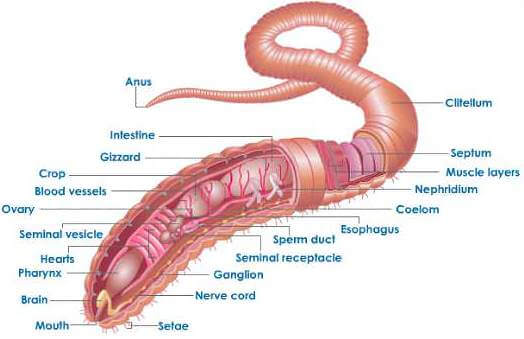In earthworm carbon dioxide and nitrogenous wastes are the main waste materials. The carbon dioxide is excreted out from the body through its moist skin by the process of diffusion. The nitrogenous wastes are excreted out of the body by special excretory organs called nephridia (singular nephridium).
A Nephridium is tubular coiled structure. It starts from a rounded funnel shaped structure called nephrostome. The nephrostome opens in a coiled tube called nephridial tubule which is lined with cilia. The nephridial tubule opens outside the body through a small opening called nephridiopore.
The body fluid of earthworm rich in nitrogenous wastes enters the nephridium through nephrostome and passes into nephridial tubule. In the nephridial tubule the useful substances present in fluid are absorbed. The remaining fluid containing high percentage of nitrogenous wastes is excreted out of the body through nephridiopore with the help of movements of cilia.

Location of nephridia in earthworm
In earthworms, the nephridia are present on septa and in the skin.The nephridia present on the septa are called septal nephridia. And the nephridia present in the skin are called integumentary nephridia.
Test Your Understanding and Answer These Questions:
- Explain the process of excretion in earthworm.
- What is nephrostome?
- Name the part of the body responsible for excretion in earthworm.
- What are the types of nephridia found in earthworm? Where are nephridia present in an earthworm?
- What happens to the useful substances which flow into nephridia in earthworm along with the waste?
